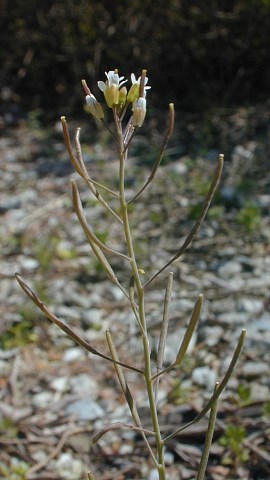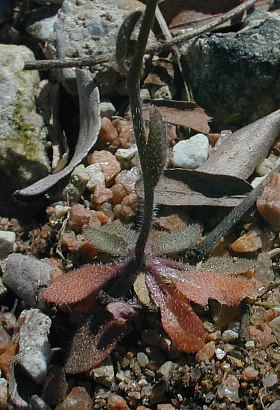Description: This plant is a winter annual, consisting of a small rosette of low basal leaves and an erect flowering stalk about 3–12" tall. The basal leaves are ½–2" long and ¼–½" across; they are dull green to red, lanceolate-oblong to oblanceolate-oblong, short-hairy on both their lower and upper sides, and smooth to slightly toothed along their margins. The central stem is unbranched or sparingly branched in the upper half. It is terete, light green to reddish brown, and hairy toward the base, becoming glabrous toward the apex. The erect to ascending cauline leaves develop alternately along each stem and they are few in number (typically 1-5 per plant). Cauline leaves are ½–1" long and 1/8–1/4" (3-6 mm.) across; they are dull green to reddish brown, narrowly elliptic-oblong, smooth along their margins, short-hairy, and sessile.

The central stem
(and upper side stems, if present) terminates in an elongated raceme.
The flowers and buds are crowded together near the apex of the raceme,
while developing seedpods are located below. Each tiny flower is about
1/8" (3 mm.) long, consisting of 4 white petals (not cleft at their
tips), 4
light green sepals, a pistil with a single style, and several stamens.
The sepals are erect and lanceolate; the petals are a little longer
than the sepals. The blooming period occurs during the spring and lasts
about 1½ months. Each flower is replaced by a hairless silique (narrow
cylindrical seedpod) about ½" long. The ascending siliques are straight
or curved slightly upward; they have short petioles up to ¼" long.
Inside each silique, there are several tiny seeds that are arranged in
a single row. The root system consists of a shallow branching taproot
with fine secondary roots. This plant reproduces by reseeding itself. 
Cultivation:
Typical growing conditions include full sun, a mesic to dry location,
and barren soil that is sandy or gravelly. This little plant develops
quickly during the cool weather of spring and withers away no later
than early summer.
Range & Habitat:
The non-native Mouse-Eared Cress is occasional in the southern half of
Illinois, but it is
rare or absent in the upper half of the state (see Distribution
Map). This plant may be spreading northward, however.
Habitats
include fields, pastures, roadsides, areas along railroads, gravelly or
sandy paths, and barren waste areas. Disturbed habitats are preferred.
Mouse-Eared Cress is native to Europe and northern Asia.
Faunal Associations:
Little information is available about floral-faunal relationships for
this species. The tiny flowers are probably cross-pollinated by small
bees and flower flies (Syrphidae). In the absence of such visitors, the
flowers are undoubtedly self-fertile.
Photographic Location:
A gravelly path at the Arboretum in Urbana, Illinois.
Comments:
This is one of many weedy annuals in the Mustard family that is native
to Eurasia. Mouse-Eared Cress resembles a cross between a Draba
sp. (Whitlow Grass) and an Arabis sp.
(Rock Cress). It is the only member of its genus in Illinois. Species
of Whitlow Grass have seedpods that are more short and fat than those
of Mouse-Eared Cress, while species of Rock Cress are usually larger in
size. A possible exception is Arabis lyrata (Sand
Cress), which has larger flowers (about ¼" across) and basal leaves
that are slightly pinnatifid, rather than entire. Although larger in
size, Arabis hirsuta (Hairy Rock Cress) is somewhat
similar in appearance to Mouse-Eared Cress. However, Hairy Rock Cress
has lower cauline leaves that clasp the stem and its seedpods are
flattened, rather than terete.